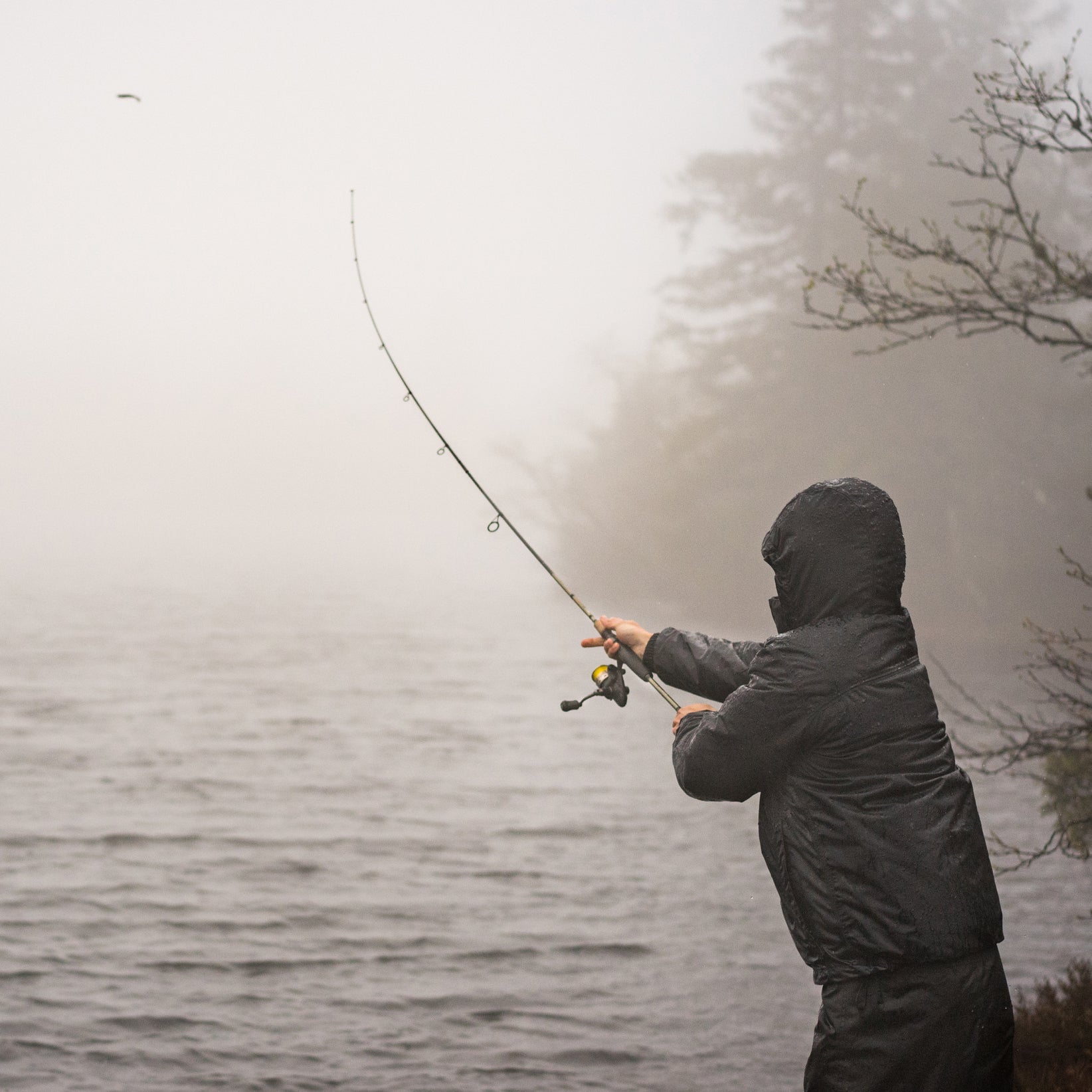A warm summer evening whiled away by the campfire. Running on the beach in a tank top. A cold beer after fishing in the sun all afternoon.
Screw that. Summer is months away, and the great outdoors is calling now. July and August may feel like the ideal time to play outside, but rain, snow, and sleet are no excuse to delay your favorite activities. We realize it’s tough to imagine how to enjoy being out there when it’s cold and wet, so we corralled a group of foul-weather experts to get their tips on how to enjoy your favorite pastimes during the rougher months.
Running
It’s 6 a.m., and the rain is freezing. There’s ice on the ground, but the precipitation is still wet and sleety. You know from experience that it’ll sting when it hits your face. How do you get out of bed? Simple: embrace the conflict.
“It’s kind of a man-versus-nature thing that’s probably hardwired into our genetic code,” says Jason Saltmarsh, a New Hampshire–based running coach and marathoner. A change of mindset might be just enough to pull your hand away from the snooze button. In driving rain, your daily three-mile jog before work can seem like a challenge to conquer, an obstacle to overcome. “Life is easy these days, and working out in miserable weather is a reminder that we possess a reserve of untapped strength and resilience,” Saltmarsh says.
Saltmarsh doesn’t take days off when the weather gets bad. “I love running in the elements,” he says. “I once ran a 14-mile workout in a hurricane just for the thrill of it.” He’s accumulated a few key pieces of practical advice.
Avoid Chafing. When Saltmarsh ran his first half marathon years ago, the rain was oppressive. “I finished with blood on my shoes, and my nipples were missing,” he wrote afterward. Nip-guards or Band-Aids will protect your chest, and smears of Vaseline, he says, will do wonders to keep your toes and heels from getting rubbed raw.
Warm Up Preemptively. A hot cup of coffee before you head out the door is “the best legal performance-enhancing drug out there.”
Gear Up. Saltmarsh doesn’t own rain-specific running shoes, but on cold days, he pulls on merino wool socks and recommends a hat for warmth (one with a brim will also keep some rain off your face) and a breathable-waterproof shell or jacket, if you have one.
Be Seen. Wear bright clothing if you’re running on the street. Reflective strips could be all a driver sees of you when it’s raining buckets.
Saltmarsh’s final bit of advice: treat yourself. “If it’s below freezing, I skip the cool-down phase and head straight to a hot shower.”
Camping
“Living in the UK, if I only went out camping in good weather, then I would rarely be out there at all—and I would go stir-crazy trapped inside four walls,” says outdoors writer .
Smith is the author of several books on camping, including Wild Nights: Camping in Britain’s Extremes, so she knows a thing or two about pitching a tent in the rain and snow. Crummy weather, she says, is no reason to sulk. “The main plus about it is that there will be a lot fewer people around, so you can get the mountains and trails pretty much to yourself,” Smith says. “Plus, good weather often follows bad. If you head out in the rain, you can very often wake up to a wonderful sunrise or a cloud inversion—and be the first out there.” That said, Smith has a few key tips.
Location Is Everything. Avoid gullies, streams, and any area that might not drain well.
Bring Protection. If you’re expecting bad weather, a tarp or two is a must. Hoist one up high for some cover when pitching your tent in a downpour, or throw one under your new home to keep it out of the flowing water. If you’ve been caught in the rain by surprise, pitch the fly first to keep the tent as dry as possible, Smith says.
Breathe. Once you’re all set up, open all the tent vents—condensation inside your tent during a cold downpour can be gnarly.
Bring Drybags. Smith doesn’t bother with a pack cover, but “I always have one main internal drybag and keep my waterproof jacket and over-trousers right at the top, and then use a small green one for my first-aid kit and head torch, red for food, and orange for warm layers,” like hats and gloves. “It may sound pedantic, but in the rain you want to avoid faffing around trying to find what you need,” she says.
Have More Layers Than an Onion. Included in Smith’s packing list: multiple gloves and good waterproof outerwear, extra base and midlayers, and waterproof matches and starters like . Also critical, Smith says, is an eye for what she calls the “I Can’t Be Bothered” factor—that moment when you think, “I should really put on dry gloves, or an extra layer, or find a hat, but I can’t be bothered right now.” “This is an early sign of hypothermia,” she says. “If you start saying it, start doing the things you should do: grab a drink, some food, and warm yourself up ASAP.”
Smith’s motto for camping outdoors, regardless of the weather, is “enjoy, not endure.” You don’t have to be British to find joy in a little rain. “There’s something I always find very comforting about lying inside a tent listening to the rain tap on the roof while I’m cozy inside my sleeping bag, drinking a hot drink,” she says. “Makes me sometimes long for the rain to come—after I’ve pitched, of course.”
Fishing
All anglers know that sometimes the rain can turn the fishing from OK to great. who competed on the Women’s Bassmaster Tour, says, “If you’re a newcomer to bass fishing, one of the best investments you can make is in a good-quality, leakproof rain suit.” Because fishing in a downpour is worth getting wet for.
What’s more, there’s a fair chance nobody else will be as crazy as you, so you may just get the whole damn lake to yourself. But there are a few things you need to know first.
Watch the Water Levels. As the lake or stream you’re fishing rises, the fish will move into shallower water, where believes —heavy lines, big baits, lots of casting—can win the day. But remember that as the water level changes, you should be changing your depth, too, Magers advises.
Bring a Jacket. Ponchos aren’t enough cover for a full day on the water. Waterproof (and breathable) bibs and jackets are the best way to deal with the deluge. Don’t forget gloves and boots. “Who wants prune feet?” writes Magers.
Go Dark. “The number-one fishing tip for bass fishing in the rain is darker lures,” Magers writes. “Any color is fine as long as it’s black.”


